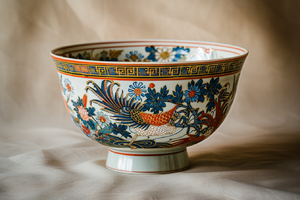کو اماری
Ko-Imari

کو-اماری (لفظی طور پر پرانی اماری) سے مراد جاپانی اماری کے سب سے قدیم اور مشہور انداز ہے جو بنیادی طور پر 17ویں صدی کے دوران تیار کیا گیا تھا۔ یہ چینی مٹی کے برتن اریتا قصبے میں بنائے جاتے تھے اور قریبی بندرگاہ اماری سے برآمد کیے جاتے تھے، جس نے اس سامان کو اس کا نام دیا تھا۔ کو-اماری اپنے متحرک آرائشی انداز اور ابتدائی عالمی چینی مٹی کے برتن کی تجارت میں تاریخی اہمیت کے لیے خاص طور پر قابل ذکر ہے۔
تاریخی پس منظر
اریٹا کے علاقے میں چینی مٹی کے برتن کی دریافت کے بعد، 1640 کی دہائی کے آس پاس، ابتدائی ایڈو دور میں Ko-Imari کا سامان ابھرا۔ ابتدائی طور پر چینی نیلے اور سفید چینی مٹی کے برتن سے متاثر ہو کر، مقامی جاپانی کمہاروں نے اپنی اسٹائلسٹک شناخت تیار کرنا شروع کی۔ جیسا کہ منگ خاندان کے زوال کی وجہ سے چین کی چینی مٹی کے برتن کی برآمدات میں کمی آئی، جاپانی چینی مٹی کے برتن نے بین الاقوامی منڈیوں میں خاص طور پر ڈچ ایسٹ انڈیا کمپنی کے ساتھ تجارت کے ذریعے خلا کو پُر کرنا شروع کیا۔
اہم خصوصیات
کو-اماری کی مخصوص خصوصیات میں شامل ہیں:
- بولڈ اور رنگین ڈیزائن، عام طور پر کوبالٹ بلیو انڈرگلیز کو سرخ، سبز اور سونے میں اوورگلیز انامیلز کے ساتھ ملاتے ہیں۔
- تقریباً پوری سطح کو ڈھانپنے والی گھنی اور سڈول سجاوٹ، جسے اکثر بہت زیادہ آرائشی یا یہاں تک کہ خوشحال کے طور پر بیان کیا جاتا ہے۔
- شکلیں جیسے کرسنتھیمس، پیونی، فونکس، ڈریگن، اور اسٹائلائزڈ لہریں یا بادل۔
- موٹی چینی مٹی کے برتن جسم بعد کے مقابلے میں، زیادہ بہتر ٹکڑے ٹکڑے.
Ko-Imari ware was not intended solely for domestic use. Many pieces were tailored to suit European tastes, which included large plates, vases, and garnitures for display.
Export and European Reception
Ko-Imari ware was exported in large quantities throughout the 17th and early 18th centuries. It became a fashionable luxury item among European elites. In palaces and aristocratic homes across Europe, Ko-Imari porcelain adorned mantelpieces, cabinets, and tables. European porcelain manufacturers, particularly in Meissen and Chantilly, began producing their own versions inspired by Ko-Imari designs.
Evolution and Transition
By the early 18th century, the style of Imari ware began to evolve. Japanese potters developed more refined techniques, and new styles such as Nabeshima ware emerged, focusing on elegance and restraint. The term Ko-Imari is now used to specifically distinguish these early exported works from later domestic or revival pieces.
Legacy
Ko-Imari remains highly valued by collectors and museums worldwide. It is considered a symbol of Japan’s early contribution to global ceramics and a masterwork of Edo-period craftsmanship. The vivid designs and technical achievements of Ko-Imari continue to inspire both traditional and contemporary Japanese ceramic artists.
Relationship to Imari Ware
While all Ko-Imari ware is part of the broader category of Imari ware, not all Imari ware is considered Ko-Imari. The distinction lies primarily in the age, style, and purpose. Ko-Imari specifically refers to the earliest period, characterized by its dynamic energy, export orientation, and richly decorated surfaces.
